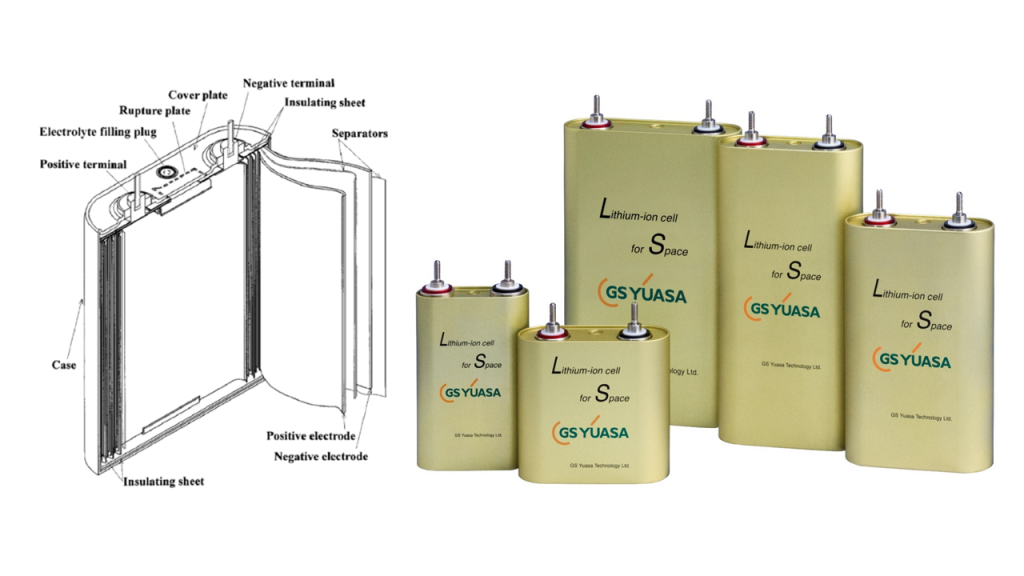Roswell, GA – GS Yuasa Lithium Power (GYLP) announced today the first delivery of the Generation 4 LSE Lithium-ion Cells for Space to a North American client. The LSE60 (60Ah, 3.75V, 225Wh) will be entered into a competitive technical evaluation for suitability in the client’s advanced spacecraft platform under development.
GS Yuasa introduced the “LSE” family of lithium-ion cells specifically designed and qualified for space applications in 1998. The first-generation LSE cells utilized a lithium cobalt dioxide cathode opposed by a graphite anode (LCO/Graphite). Over the next two-decade period there have been only 4 major revisions, or generations, of the LCO/Graphite cell chemistry foundation. The generation changes are only released after completion of an exhaustive qualification process to ensure the targeted optimizations proposed lead to measurable improvement of the various key performance metrics while maintaining the accumulated heritage of the LSE cell family.
Investigation of the Generation 4 chemistry started as early as 2014. GS Yuasa recognized improvements to the critical raw active materials driven primarily by improved manufacturing techniques allowing for tighter control of the material specifications. Comprehensive analysis of numerous improved candidate active materials took place over the next several years. Adjacent to the performance metrics of each material, GS Yuasa actively studied the supplier’s ability to provide the material over the next decade or longer. This is a critical consideration of any prospective material to be used in a GS Yuasa cell.
The physical construction of the Generation 4 cells remains unchanged relative to previous generations. This continuity is critical and allows GS Yuasa to maintain all of the heritage accumulated with the LSE family of cells. Like the Generation 3 cells, the Generation 4 cells will be available in either an energy optimized electrode (standard) or power optimized electrode. The only difference between the two electrodes is coating thickness.


The Generation 4 cell line-up consists of the heritage case form factors as identified in the tables above. Each of the 4 possible case sizes have been built and qualified. The possible Generation 4 cells all exist at some level of development. Some configurations are still being studied and others have fully completed flight qualification and are ready for market.
With volumes of life and performance data available and a solid connection between industry leading spaceflight heritage without failure and the Li-ion cells offered today, GS Yuasa’s value proposition is stronger now than ever.
To learn more about GS Yuasa’s LSE family of Li-ion cells for space, please contact GS Yuasa Lithium Power, Inc.
About GS Yuasa Corporation
GS Yuasa Corporation was established in 2004 by the merger of Japan Storage Battery Co., Ltd and YUASA Battery. GS Yuasa develops and manufactures batteries and power supply systems for a wide range of special applications. The company’s high-performance, high-quality batteries are installed in sea, land, and aerospace environments, from depths of 6,500 meters below the ocean surface to 36,000 kilometers in space.
http://www.gs-yuasa.com/jp/ (Japanese)
https://www.gs-yuasa.com/en/ (English)
About GS Yuasa Technology, LTD (GYT)
GS Yuasa Technology is a subsidiary of GS Yuasa Corporation located in Kyoto, Japan. GYT designs and manufacturers large format lithium ion cells for aerospace and specialty applications.
1-37 Osadano-cho Fukuchiyama-shi
Kyoto pref. 620-0853, Japan
Phone: 81-773-20-2630
About GS Yuasa Lithium Power (GYLP)
GS Yuasa Lithium Power, Inc. is the United States subsidiary of GS Yuasa focused on large format lithium-ion battery system manufacturing for US customers. Primary products are lithium-ion battery systems for aerospace, undersea, and defense applications. https://gsyuasa-lp.com/


